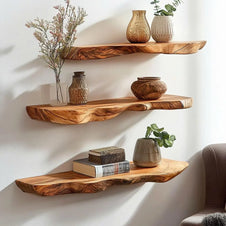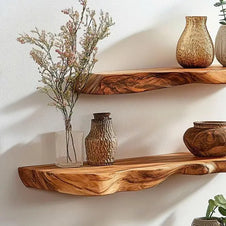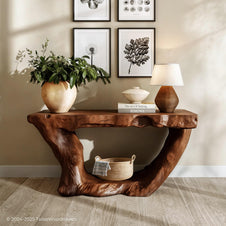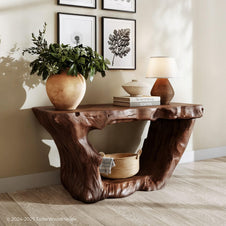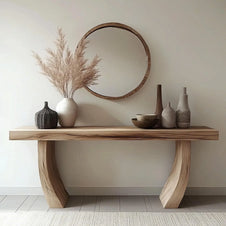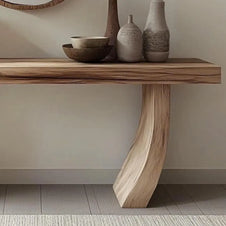When it comes to wall shelves, depth is everything. If you’ve ever wondered how deep should wall shelves be, this guide has the answers. We’ll walk you through everything you need to know, from room function and storage needs to material selection—with a special spotlight on rustic wood shelves. By the end, you’ll know exactly how deep should wall shelves be for your space.
Why Shelf Depth Matters
Shelf depth affects both aesthetics and usability. Too shallow, and you’ll constantly struggle to fit anything on them. Too deep, and your shelves might protrude into the room, look clunky, or feel unstable. For rustic wood shelves in particular, the weight of the wood itself can become a concern at greater depths, especially with live-edge or reclaimed wood.
How Deep Should Wall Shelves Be for Every Room?
Different rooms = different needs = different shelf depths, this is the most basic formula to solve the biggest question “How Deep Should Wall Shelves Be?”. Here’s a quick breakdown of the most common shelf depth recommendations by space:
|
Room/Use
|
Recommended Depth
|
Purpose
|
|
Decorative shelves
|
6–10 inches
|
Display frames, small plants, candles
|
|
Bookshelves
|
10–12 inches
|
Store most book sizes comfortably
|
|
Kitchen shelves
|
12–16 inches
|
Plates, jars, bowls, small kitchen appliances
|
|
Bathroom shelves
|
5–8 inches
|
Toiletries, towels, and baskets
|
|
Utility/TV shelves
|
16+ inches
|
Heavier equipment, TV boxes, tools, etc.
|
Key Factors That Affect Ideal Shelf Depth
What You Plan to Store
One of the first questions to ask is: “What will go on this shelf?” right before we surely know how deep should floating wall shelves be. The items you intend to store—or display—will directly determine how deep your shelf needs to be. Let’s break it down:
-
Paperback books can fit easily on shelves as shallow as 6–8 inches.
-
Hardcover novels or art books typically require 10–12 inches to avoid overhanging.
-
Decorative objects such as vases, framed photos, or candles vary in size, but a safe starting depth is 8–10 inches.
-
Spice jars and kitchen containers can usually sit well on 4–6 inch shelves, though deeper shelves offer better stability for larger jars.
-
Baskets and bins, often used in bathrooms or mudrooms, might require 10–14 inches depending on their size.
To avoid frustration, measure the largest item you plan to store and add at least 1–2 inches of clearance—both for visual breathing space and ease of use.
Pro tip: Don’t forget to account for items that protrude, like handles on pots or knobs on jars.
Room Size and Layout
Your shelf needs to make sense in the context of your room—especially when space is limited.
In small rooms, shelves that are too deep can quickly become obstacles. They may:
-
Make the room feel cramped
-
Block walkways or bump into doors
-
Distract from other design elements
For example:
-
In hallways or entryways, opt for shallow shelves (6–8 inches) to hold keys, small décor, or mail.
-
In small bathrooms, shelves deeper than 8 inches can overwhelm the space and interfere with movement, especially if mounted above the toilet or sink.
-
For narrow kitchens, deeper shelves (12–16 inches) are fine, but they need to be installed with extra care to avoid blocking cabinet doors or counters.
Handcrafted tree bookshelf collection designed to fit naturally into any corner space
Safety and Support
The deeper the shelf, the more leverage and downward force it exerts on the wall brackets and anchors. If the support system isn’t strong enough, especially with heavy rustic wood, the entire setup may fail over time.
-
Shelves up to 10 inches deep can typically be mounted with standard L-brackets and wall anchors (but ideally into wall studs).
-
Shelves 12 inches and deeper should always be installed into wall studs and paired with heavy-duty brackets or floating shelf hardware.
-
For rustic wood shelves that use thick, solid wood (like reclaimed oak or live-edge walnut), the weight can be significant—even before placing items on top.
Height of Installation
-
Eye-level installation for decorative shelves: 57–60 inches from the floor.
-
Above furniture (like sofas or beds): Leave at least 10–12 inches between the top of the furniture and the bottom of the shelf.
-
Above counters or toilets: Mount the shelf 15–24 inches above to leave room for objects and headspace.
-
For deep kitchen shelves (12–16 inches): keep them shoulder height or lower, unless used purely for display.
Wall Type and Construction
Before deciding on a shelf depth, consider what kind of wall you’re working with:
-
Drywall with wood studs is ideal for most installations—just make sure to anchor your brackets into the studs.
-
Plaster walls can be more brittle, so you'll need special anchors or toggle bolts.
-
Brick or concrete walls can support deeper shelves and heavier items, but require masonry tools and anchors.
Traffic Flow and Daily Use
Think about how people move around the room. Shelves that protrude too far into walkways can be both annoying and dangerous. As a rule of thumb:
-
For hallways or high-traffic areas: Stick to <8 inches deep.
-
Above a desk, bed, or sofa: You can go 10–12 inches if well supported.
-
In entryways: Slim floating shelves (5–6") are perfect for keys, mail, and small decor.
How Deep Should Wall Shelves Be? What to Consider with Rustic Wood Shelves
Wood Type
Rustic shelves often use solid, reclaimed, or live-edge woods like pine, cedar, oak, or walnut. These woods are beautiful—but dense and heavy. Choose a thickness that complements your desired depth.
Weight and Warping
Deep rustic shelves (12"+) need more support to prevent sagging over time. Always check the moisture level of your wood to avoid future warping.
Design Tip
Live-edge rustic shelves work best in the 8–12 inch range for balance and function. They offer enough depth for decor while preserving the natural shape of the wood.
Shelf Thickness vs. Depth
Shelf thickness plays a big role in how deep it can be without sagging. As shelf depth increases, so should the thickness. Here's a quick rule:
-
6–8" deep: ¾" thick is usually enough
-
10–12" deep: Go for at least 1" thic
-
16"+ deep: Use 1.25"–1.5" thick or reinforced wood
Get clarity on shelf proportions with this helpful floating shelf depth breakdown
Environmental Conditions
Rustic wood is sensitive to humidity and temperature changes, especially in kitchens and bathrooms. Here’s how to protect your shelves:
-
Use polyurethane or wax finish to seal against moisture.
-
Allow wood to acclimate to your room before mounting (1–2 days indoors).
-
Avoid placing rustic wood shelves directly over heat vents or in direct sunlight to prevent cracking.
How Brackets and Mounting Systems Impact the Depth of Wall Shelves
For Shelves Under 10” Deep:
For Shelves Over 12” Deep:
-
Use heavy-duty floating shelf brackets rated for higher loads.
-
Install into wall studs, not just drywall.
-
Add a center bracket every 24–30 inches for longer shelves.
Spacing Tips:
-
2 brackets for shelves under 36”
-
3 brackets for shelves 36–60”
-
Add more based on the weight you plan to store
Design Tips for a Rustic Look That Works
Proportion is Everything
Shelves that are too deep may stick out awkwardly. Try to match the depth with the size of the wall and objects below (like a counter or sofa).
Layering Decor
Use deeper shelves (10–12”) to layer items: picture frames in the back, candles or books in the front. Shallower shelves work best for minimalist setups.
Mix Function with Texture
Rustic shelves often have knots, cracks, and color variation. Let that natural charm shine! Don’t overcrowd the shelf.
Keep Heavy Items Toward the Wall
To avoid tipping or sagging, keep heavier items closer to the wall, and lighter decor near the front edge.
 Follow these rustic styling techniques to create wall shelves that feels handcrafted and complete.
Follow these rustic styling techniques to create wall shelves that feels handcrafted and complete.
Conclusion: Make It Fit Your Needs
There’s no universal answer to “how deep should wall shelves be?”—but if you understand your space, your needs, and your style, you can confidently choose the right depth every time. If you're going for a warm, handcrafted feel, rustic wood shelves offer timeless charm—but they also require thoughtful planning, especially with deeper designs.

